
Sutton Hoo is the site of two Anglo-Saxon cemeteries dating from the 6th to 7th centuries near Woodbridge, Suffolk, England. Archaeologists have been excavating the area since 1938, when an undisturbed ship burial containing a wealth of Anglo-Saxon artifacts was discovered. The site is important in establishing the history of the Anglo-Saxon kingdom of East Anglia as well as illuminating the Anglo-Saxons during a period which lacks historical documentation.

Marlborough is a market town and civil parish in the English county of Wiltshire on the Old Bath Road, the old main road from London to Bath. The town is on the River Kennet, 24 miles (39 km) north of Salisbury and 10 miles (16 km) southeast of Swindon.
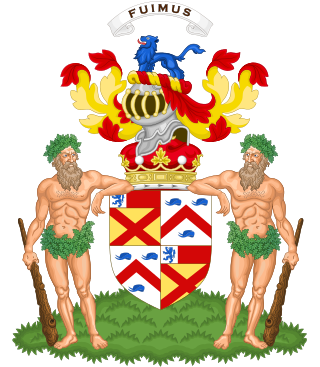
Marquess of Ailesbury, in the County of Buckingham, is a title in the Peerage of the United Kingdom. It was created on 17 July 1821 for Charles Brudenell-Bruce, 2nd Earl of Ailesbury.

The Vale of Pewsey or Pewsey Vale is an area of Wiltshire, England to the east of Devizes and south of Marlborough, centred on the village of Pewsey.
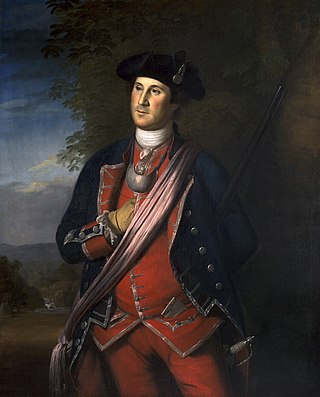
A gorget was a band of linen wrapped around a woman's neck and head in the medieval period or the lower part of a simple chaperon hood. The term later described a steel or leather collar to protect the throat, a set of pieces of plate armour, or a single piece of plate armour hanging from the neck and covering the throat and chest. Later, particularly from the 18th century, the gorget became primarily ornamental, serving as a symbolic accessory on military uniforms, a use which has survived in some armies.

Easton Royal is a village in the civil parish of Easton in Wiltshire, England, about 3 miles (5 km) east of Pewsey and 5 miles (8 km) south of Marlborough. The village was the location of Easton Priory from 1234 to 1536. The village mistakenly gained the Royal suffix in 1838 and the name Easton Royal has been in general use since the 1850s.

Seymour, Semel or St. Maur, is the name of an English family in which several titles of nobility have from time to time been created, and of which the Duke of Somerset is the head.
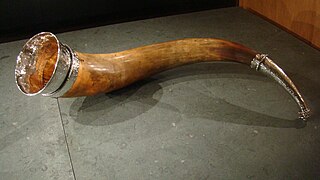
A drinking horn is the horn of a bovid used as a drinking vessel. Drinking horns are known from Classical Antiquity, especially the Balkans, and remained in use for ceremonial purposes throughout the Middle Ages and the Early Modern period in some parts of Europe, notably in Germanic Europe, and in the Caucasus. Drinking horns remain an important accessory in the culture of ritual toasting in Georgia in particular, where they are known by the local name of kantsi.

Savernake Forest stands on a Cretaceous chalk plateau between Marlborough and Great Bedwyn in Wiltshire, England. Its area is approximately 4,500 acres.

Dürer's Rhinoceros is the name commonly given to a woodcut executed by German artist Albrecht Dürer in 1515. Dürer never saw the actual rhinoceros, which was the first living example seen in Europe since Roman times. Instead the image is based on an anonymous written description and brief sketch of an Indian rhinoceros brought to Lisbon in 1515. Later that year, the King of Portugal, Manuel I, sent the animal as a gift for Pope Leo X, but it died in a shipwreck off the coast of Italy. Another live rhinoceros was not seen again in Europe until Abada arrived from India to the court of Sebastian of Portugal in 1577.

Olifant was the name applied in the Middle Ages to a type of carved ivory hunting horn created from elephant tusks. Olifants were most prominently used in Europe from roughly the tenth to the sixteenth century, although there are later examples. The surviving inventories of Renaissance treasuries and armories document that Europeans, especially in France, Germany and England, owned trumpets in a variety of media that were used to signal, both in war and hunting. They were manufactured primarily in Italy, but towards the end of the fifteenth and early sixteenth centuries, they were also made in Africa for a European market. Typically, they were made with relief carvings that showed animal and human combat scenes, hunting scenes, fantastic beasts, and European heraldry. About seventy-five ivory hunting horns survive and about half can be found in museums and church treasuries, while others are in private collections or their locations remain unknown.
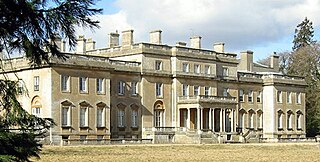
Tottenham House is a large Grade I listed English country house in the parish of Great Bedwyn, Wiltshire, about five miles southeast of the town of Marlborough. It is separated from the town by Savernake Forest, which is part of the Tottenham Park estate.

Charles Brudenell-Bruce, 1st Marquess of Ailesbury,, styled The Honourable Charles Brudenell-Bruce from birth until 1783, Lord Bruce until 1814 and The Earl of Ailesbury until 1821, was a British peer and politician.

Chandos Sydney Cedric Brudenell-Bruce, 7th Marquess of Ailesbury, styled Earl of Cardigan or Lord Cardigan between 1911 and 1961, was a British peer.

David Michael James Brudenell-Bruce, 9th Marquess of Ailesbury, styled The Hon. David Brudenell-Bruce until 1974 and Earl of Cardigan between 1974 and 2024, is a British peer.
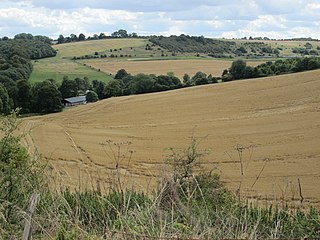
Hippenscombe is a hamlet within the civil parish of Tidcombe and Fosbury, Wiltshire, in the southwest of England. Marked only on large-scale maps, it lies to the southwest of Oakhill Wood and the northwest of Conholt Park, about 8 miles (13 km) south of Hungerford, Berkshire.
African ivories are objects and materials that are created from ivory or include ivory material that comes from the continent of Africa. The ivory from Africa would become widely sought after by the 14th century due in part to the poorer quality of Asian ivory. While Asian ivory is brittle, more difficult to polish, and tends to yellow with exposure to air, African ivory often comes in larger pieces, a more sought after cream color, and is easier to carve. Ivory from Africa came from one of two types of elephant in Africa; the more desirable bush elephant with larger and heavier tusks or the forest elephant with smaller and straighter tusks.

The Church of Saint Mary the Virgin is the parish church of Great Bedwyn, Wiltshire, England, and a Grade I listed building. The church was built in the Norman style in the 12th century, but beneath the existing building are Saxon remains dating back to the 10th century. The church boasts a handsome memorial to Sir John Seymour, father of King Henry VIII's wife Jane Seymour, and grandfather of King Edward VI of England.

Nafir, also nfīr, plural anfār, Turkish nefir, is a slender shrill-sounding straight natural trumpet with a cylindrical tube and a conical metal bell, producing one or two notes. It was used as a military signaling instrument and as a ceremonial instrument in countries shaped by Islamic culture in North Africa, the Middle East and South Asia. In Ottoman, Persian and Mugulin miniatures, the nafīr is depicted in battle scenes. In Christian culture, it displaced or was played alongside of the curved tuba or horn, as seen in artwork of about the 14th century A.D.
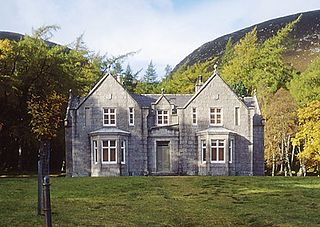
In Great Britain and Ireland a sporting lodge – also known as a hunting lodge, hunting box, fishing hut, shooting box, or shooting lodge – is a building designed to provide lodging for those practising the sports of hunting, shooting, fishing, stalking, falconry, coursing and other similar rural sporting pursuits.



















